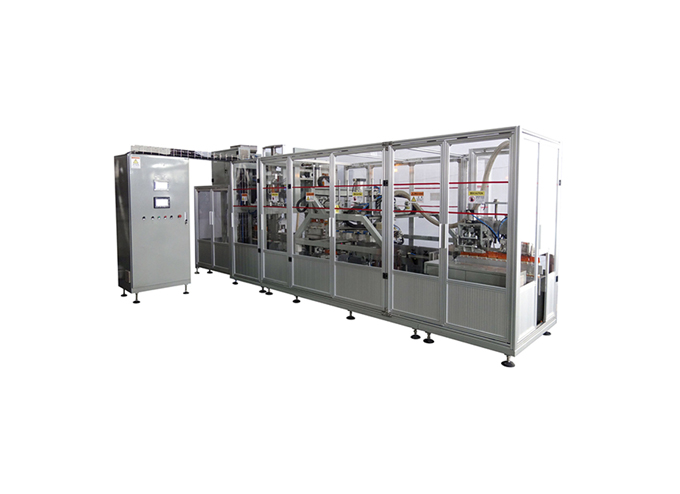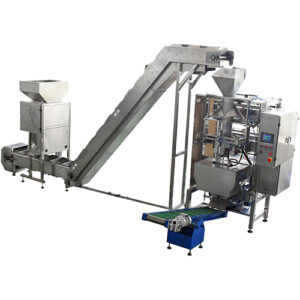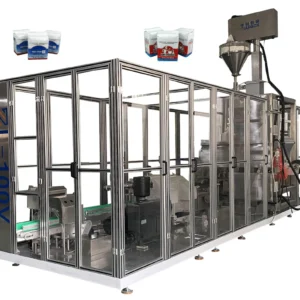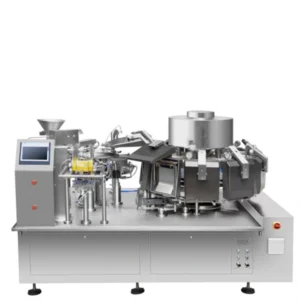Description
| Parameter | Specification |
|---|---|
| Machine Model | QBVPM-3000 |
| Bag Types Supported | Brick-shaped, vacuum-sealed bags |
| Bag Dimensions | Length: 150mm – 300mm<br> Width: 80mm – 200mm |
| Vacuum Pressure | -0.08 MPa (-600 mmHg) |
| Sealing Method | Heat sealing |
| Speed | Up to 40 bags per minute |
| Power Supply | 220V/50Hz or 380V/60Hz, 3 phase |
| Power Consumption | 7 kW |
| Air Pressure | 0.6 MPa (87 psi) |
| Air Consumption | 0.6 m³/min (21 CFM) |
| Machine Weight | 1500 kg |
| Machine Dimensions (LxWxH) | 2500mm x 1800mm x 2000mm |
| Material | Stainless Steel 304 |
| Control System | PLC (Programmable Logic Controller) |
| Touchscreen Interface | 12-inch color touchscreen |
| Filling System | Auger filler or weigh filler |
| Vacuum Pump | Rotary vane or dry vacuum pump |
| Safety Features | Emergency stop button, safety sensors, guardrails |
| Optional Features | Date coding, gas flushing, nitrogen injection, etc. |
In packaging technology, innovations are constantly changing industry standards. The Granule Brick Bag Vacuum Packaging Machine is an example of these innovations that help streamline the packaging process while maintaining the freshness and quality of granular products. In this comprehensive guide, we will explore the various processing methods, implementation areas, task assignments, benefits, responsibilities, and positive outcomes related to this machine.
Processing Methods
The Granule Brick Bag Vacuum Packaging Machine uses several advanced procedures for efficient packaging of granular products:
Feeding: At this level, the hopper on the machine is loaded with granular products to start packing.
Weighing and Measuring: This machine employs accurate weighing techniques that allow it to measure the right amount of granules for each pack thus ensuring uniformity and correctness.
Filling: These measured grains are then filled into special brick-shaped bags by use of a filling unit.
Vacuum Sealing: One of its major steps is vacuum-sealing the bags to discard any excess air hence sustaining product quality in terms of freshness.
Heat Sealing: After vacuum sealing, heat sealing follows where bags become airtight preventing leakages or mixing with other substances.
Quality Control: As part of packaging processes, there are quality control devices integrated into machines to detect any faults or nonexistence in every pack ensuring no contamination has occurred during this process till the end point.
Packaging and Discharge: Finally, she sealed and labeled bags dropped out from the device ready for distribution or sale elsewhere as required.
Implementation Areas
The versatility exhibited by the Granule Brick Bag Vacuum Packaging Machine enables it to be utilized across different industries:
Food Industry: It has numerous applications in the food industry whereby different types of grain foods such as rice cereals pulses nuts snacks etc…are packed using it.
Pharmaceutical Industry: In packaging granular medicines, supplements, and vitamins, pharmaceutical companies also depend on these machines.
Chemical Industry: Manufacturers of various chemicals pack granular substances such as fertilizers, pesticides, or detergents using them.
Pet Food Industry: For pet food and pet treats manufacturers use these devices to pack kibble, and treats among other granulated materials for pets.
Agricultural Sector: These are used in agriculture to package seeds, fertilizer feeds, and other granulate agricultural products.
Task Assignments
The Granule Brick Bag Vacuum Packaging Machine assigns tasks all through the process of packaging to ensure efficiency and accuracy:
Feeding: Loading of granular products into the machine’s hopper initiates the packing process.
Weighing and Measuring: An accurate measurement is done to ascertain the right quantity of a given dosage in grams relative to each bag for consistency purposes.
Filling: Pouring measured grains into a compartment which allows even distribution within each bag.
Vacuum Sealing: Allowing air out by vacuum sealing removes unnecessary gases thus preserving the freshness and quality of the product inside these packages made of bricks or bags shaped that way respectively.
Heat Sealing: Heat sealing is used after vacuum-sealing whereby the bags are sealed tightly so that no leakage arises from them or contamination occurs during storage.
Quality Control: It monitors whether there could be any defects all along its packaging process until the endpoint where none should occur under normal circumstances.
Benefits
Adopting Granule Brick Bag Vacuum Packaging Machines offers multiple advantages to businesses across different sectors:
Freshness Preservation: This helps in keeping intact freshness, flavor plus nutritional value for granules packed therefore extending their shelf life.
Enhanced Product Safety: Airtight packaging prevents contamination and maintains the product’s safety by meeting regulatory requirements.
Improved Shelf Appeal: Well-packaged products have a pleasing appearance in stores, thus attracting customers and leading to sales in retail environments.
Increased Efficiency: Automated packaging processes enhance efficiency, hence productivity, and this reduces labor costs among other things that improve overall operational efficiency.
Customization Options: The machines can offer a range of various designs for packaging and labeling on the packages as per company requirements and consumer preferences in this market space.
Responsibilities
There are several tasks that the Granule Brick Bag Vacuum Packaging Machine does during the packing process:
Ensuring Accuracy: Ensuring accuracy while measuring or filling granulated items to maintain consistency as well as quality standards.
Maintaining Quality Standards: Maintaining strict control measures for quality aimed at guarding packaged products’ integrity and safety.
Preventing Contamination: Coming up with strategies that can prevent contamination of goods throughout the entire packaging process for safe packaging purposes.
Optimizing Efficiency: Maximizing delivery efficiency to meet production demands, while minimizing operational costs amongst others associated with this field respectively.
Positive Outcomes
Through businesses adopting Granule Brick Bag Vacuum Packaging Machines, they can realize several positive outcomes:
Increased Productivity: Automated packing ensures faster production rates thereby allowing firms to be more responsive to market requirements resulting from such automation processes.
Enhanced Product Quality: Sealing vacuum preserves flavor plus texture of granular materials thus making them better sellers also enhancing the consumers’ satisfaction.
Cost Savings: Reducing labor costs along with enhanced operational efficiencies such as decreased wastages on products leads to significant savings across industries.
Improved Customer Satisfaction: Properly packed products that have preserved taste and aroma make clients happy leading to repeat sales as well as referrals through word-of-mouth marketing techniques.
FAQs
What is a Granule Brick Bag Vacuum Packaging Machine?
A Granule Brick Bag Vacuum Packaging Machine refers to a specialized machine used for packing granular products into brick-shaped bags by vacuum sealing.
What types of products can be packaged using these machines?
These machines can be used to package different kinds of granular products including foodstuffs, drugs, pet items, chemicals, and agricultural inputs among others.
How does vacuum sealing benefit the packaging process?
Vacuum sealing removes air from packages hence extending the shelf life of the product by preventing oxidation and spoiling.
What factors should be considered when selecting a machine?
Factors like production rates, packaging personalization options, reliability, nature of maintenance required as well and suitability for particular goods must be evaluated to selecting any machine.
Are there any regulatory standards associated with these machines?
Food safety and equipment are among the regulations followed when manufacturing such items for consumer safety and meeting regulatory requirements.
Can these machines handle different types and sizes of granular products?
Yes, they can accommodate various types and sizes thus giving them flexibility plus versatility on packaging aspects.
What maintenance procedures are required for these machines?
Regular cleaning, lubrication, as well as inspection, are important to maintain their optimum performance and extend the functioning duration.
How does packaging with these machines impact product shelf life?
Vacuum sealing maintains freshness that keeps the food in good condition while still increasing durability by eliminating spoilage due to exposure to air through this process of filling up cartons.
What are the environmental implications of using these machines?
Reducing wastage on foods also encourages sustainability through prolonging shelf lives hence minimizing the need for excessive materials necessary for packaging purposes.
Are there any additional features available with these machines?
Some of them come with added features such as self-labeling, coding, or personalized packaging designs that enhance their appeal to consumers and create a brand.





